Cadastral fabric source data |
|
|
Release 9.3
Last modified May 27, 2009 |



|
When building your cadastral fabric, you will be able to use, as a starting point, your existing parcel datasets that you have built and maintained over time. Parcel-based GIS datasets and COGO coverages can be migrated into the cadastral fabric using cadastral fabric data importer.
To successfully migrate data into the cadastral fabric, an understanding of the cadastral fabric data model is necessary.
The cadastral fabric data model
Parcels in the cadastral fabric are composed of parcel line features, parcel point features, and parcel polygon features. Parcel topology is stored explicitly through shared, common parcel point features.
Parcel lines represent the boundaries for parcel polygons. Parcel lines also include connection lines and radial lines. Parcel lines store dimension attributes, which match the dimensions on the record of survey. Each parcel line in the cadastral fabric is a two-point line, "from" one point "to" the other. These points are the parcel point features.
Most parcel points represent parcel corners. Parcel points can also represent centerpoints of curved boundaries and endpoints of connection lines. Parcel corner points are common points between shared parcel boundaries. A parcel boundary shares the same parcel corner point with its neighboring boundaries, thus establishing connectivity in the boundary network. Parcel points store x,y attributes, which are initially generated from either data migration or parcel joining, and are adjusted by the least-squares adjustment.
Learn more about the parcel data model in the cadastral fabric.
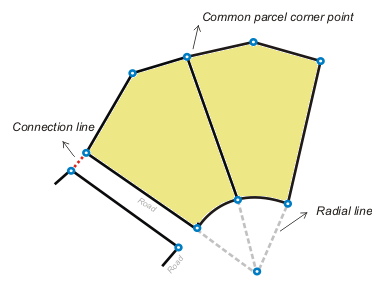
Formatting feature classes for data migration
Existing, parcel-based GIS data needs to be formatted correctly to be migrated into the cadastral fabric data model. The three primary features that comprise a parcel need to be well defined, in separate feature classes, in the source data. These features are
- Parcel lines
- Parcel corner points (nodes)
- Parcel polygons
All three feature classes need to have the same name, but with _arc appended to the lines feature class, _node appended to the points feature class, and _polygon appended to the polygon feature class. Feature classes that have been correctly formatted to be successfully migrated into the cadastral fabric are known as fabric source data.

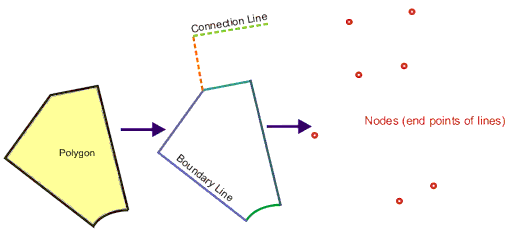
COGO coverages are also considered fabric source data but are already in the correct format for data migration into the cadastral fabric.
Parcel lines
Parcel lines in the cadastral fabric store recorded dimensions in COGO attributes (shown in red).
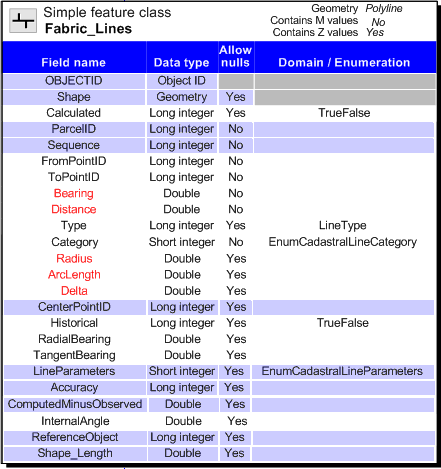
Lines being migrated into the cadastral fabric, or source parcel lines, should have the same COGO attributes storing the same recorded dimensions. The data migration process builds the cadastral fabric parcels using the dimensions stored in the COGO attributes on the source parcel lines (not from the line shape geometry). If there are no COGO attributes on your source parcel lines, the data migration process will invert the line shape geometry to generate dimensions in the COGO attributes. The cadastral fabric parcels will then be built from the line shape geometry.
Source parcel lines should be individual line segments that connect to form the parcel polygon. Source parcel lines should not be polylines or multipart features.
COGO fields
The following COGO fields are required in your source parcel lines table:
| Field Name | Field Type | Description |
| BEARING (or ANGLE, DIRECTION, or AZIMUTH) | String | The recorded bearing/direction |
| DISTANCE | String | The recorded distance |
| RADIUS | String | The distance from the center point to the arc of a curve |
| DELTA | String | The angle at the center of a curve |
| ARCLENGTH | String | The length of the curve arc |
| SIDE | String | Specifies whether the curve is extending Left or Right |
The bearings (directions) of your source parcel lines should be stored in a Bearing (or Angle, Direction, or Azimuth) field. The recorded bearing units can be set to any of the units supported by the data migration process. You can set your source units in the Import Fabric Data wizard. These units are
- Degrees/Minutes/Seconds
- Decimal Degrees
- Radians
- Gons
- Gradians
The direction types supported by the data migration process are
- Quadrant Bearing
- North Azimuth
- South Azimuth
- Polar
The cadastral fabric is created as a new node under a feature dataset. Therefore, the cadastral fabric inherits the spatial reference of the feature dataset. The distance units on your source lines should be set to the units of the spatial reference of your cadastral fabric.
Topological fields
In addition to the COGO fields, the following topological fields are required in your source parcel lines table:
| Field Name | Field Type | Description |
| FNODE_ (or FROMPT or FROMPOINT) | Long Integer | The from point of the line |
| TNODE_ (or TOPT or TOPOINT) | Long Integer | The to point of the line |
| LPOLY_ (or LEFTPOLY or LEFTPOLYGON) | Long Integer | The left polygon |
| RPOLY_ (or RIGHTPOLY or RIGHTPOLYGON) | Long Integer | The right polygon |
The FNODE_ (or FROMPT or FROMPOINT) field stores a reference to the from point of the line. The line feature references the from point in the corresponding point feature class (_node) by the point's feature ID. Similarly, the TNODE_ (or TOPT or TOPOINT) field stores a reference to the to point of the line, and the feature ID of the to point is stored in the TNODE_ field. The left parcel polygon is on the left side of the parcel line going in the direction of the from point to the to point. The polygon in the corresponding polygon feature class (_polygon) is referenced by feature ID in the lines table. Likewise, the right parcel polygon is on the right side of the parcel line going in the direction of the from point to the to point and is referenced by feature ID.
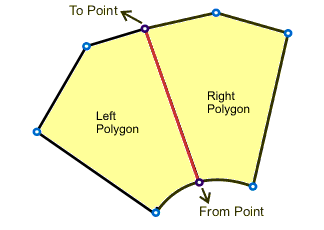
Optional fields
The following fields are optional on your source parcel lines table. Depending on the quality of data being migrated, some of these fields may be necessary. For example, if you are maintaining connection lines (across roads or to control) in your source parcel data, the Category field is necessary for specifying the connection line category. If you are assigning accuracy levels to some or all of your parcel lines, an AccuracyCat field is necessary for specifying the accuracy category or level. By default, all parcel polygons and their lines are assigned an accuracy level of 3 unless otherwise specified in the AccuracyCat field on your source parcel lines or polygons. The accuracy level of a parcel polygon automatically gets propagated down to its related set of lines. You can override the parcel level accuracy by assigning accuracy levels to your individual parcel lines.
| Field Name | Field Type | Description |
| Category | Long Integer | The line category (e.g., boundary line or connection line) |
| Calculated | Long Integer | True if dimensions are inverted from line shape geometry |
| Type | Long Integer | Used for custom subtypes on the lines (e.g., road frontage, back lot line) |
| AccuracyCat (or ACCURACY) | Long Integer | The accuracy level of the line |
If you have no COGO attributes on some of your source parcel lines, the data migration process will automatically generate COGO attributes for you by inversing the line shapes. If you have a Calculated field on your source parcel lines, you can set the field value to True for all lines with no COGO attributes. This will help you distinguish between the lines in your cadastral fabric that have inverted COGO dimensions and the lines that have COGO dimensions from the record.
The Type field is used when you have your own custom subtypes on your source parcel lines. You will need to create the same subtype on the system Type field of the cadastral fabric lines table for your subtypes to migrate successfully.
If any of the optional fields are missing on your source parcel lines, corresponding fields in the cadastral fabric lines table will have the following values:
- No Category field: Category = Boundary line (All lines in your cadastral fabric will be set to the Boundary line category.)
- No Calculated field: Calculated = NULL
- No Type field: Type = NULL
- No AccuracyCat field: Accuracy level = 3
Setting connection lines in your source parcel lines
You can set up connection lines in your parcel data before migration into the cadastral fabric. In the cadastral fabric, connection lines can be added as a side shot in a parcel traverse or by using the Create Connection tool
Follow these steps to add connection lines to your source parcel lines:
- Create a Category field on your source parcel lines table.
- In ArcMap, add your connection lines, using standard editing tools, to your source parcel lines feature class.
- Set the category of the new lines to 3 (connection).
- Load both your source parcel points and source parcel polygon feature classes.
- Create new points/nodes at the endpoints of your newly added connection lines.
- Populate the FNODE and TNODE attributes of your newly added connection lines. The FNODE and TNODE values are those values found under the "_" or "#" field in the source parcel points feature class.
- Populate either the LPOLY or RPOLY attributes of the newly added connection line. The LPOLY or RPOLY values are those values found under the "_" or "#" field in the source parcel polygons feature class.
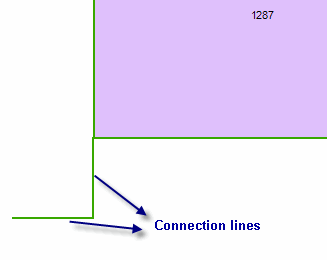
Add connection lines to source parcel data
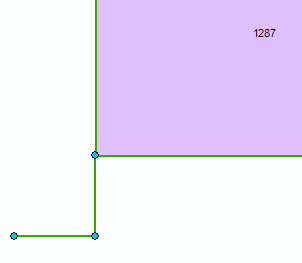
Add new nodes to end points of connection lines
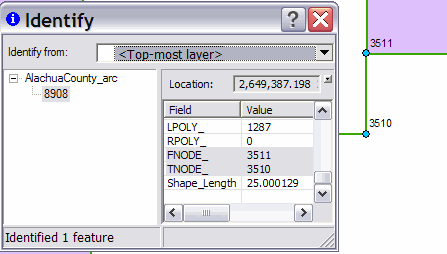
Populate from and to nodes of connection lines
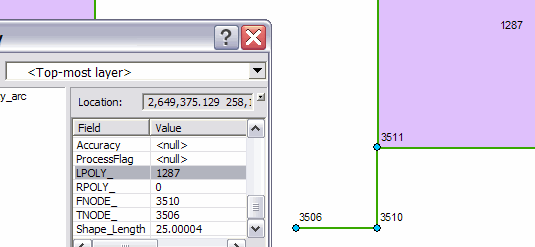
Populate either the left or right polygon ID of the connection line
Parcel points
Parcel points in the cadastral fabric store x,y,z coordinates for the parcel corners (shown in red). Initial coordinates are generated during the data migration or parcel joining process, and the x,y coordinates are updated in the least-squares adjustment.
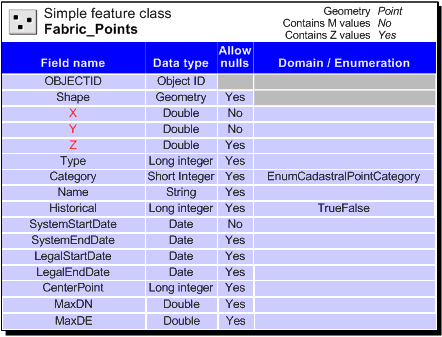
Lines being migrated into the cadastral fabric should have a corresponding feature class of points or nodes (_node). The points are the endpoints of the lines and are also the parcel corner points. For adjacent parcel corners, there is one common point. Common points maintain topological integrity between parcels and define connectivity in the network. Source parcel lines reference the points by their feature IDs.
You do not need to have x,y,z fields on your source parcel points. These values are generated from the point shapes during the data migration process.
Required fields
The following COGO system field is required on your source parcel points table:
| Field Name | Field Type | Description |
| Your feature class name with an underscore | Long Integer | System field required for data migration |
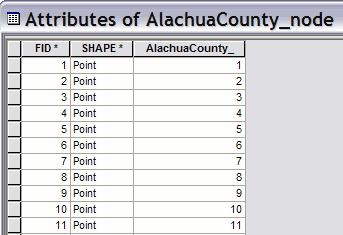
Optional fields
The following fields are optional on your source parcel points table:
| Field Name | Field Type | Field Description |
| Category | Long Integer | The point category (e.g., corner point or centerpoint) |
| LinePntParcel (or Linepointparcel) | Long Integer | The feature ID of the adjacent parcel (in the COGO system field in the _polygon table), which has the line point on its boundary line |
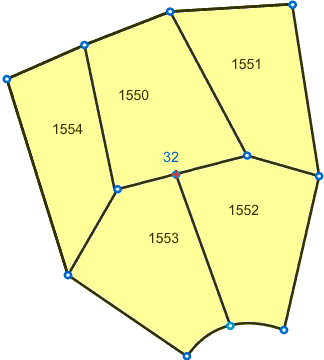
Learn more about line points.
If any of the optional fields are missing on your source parcel points, corresponding fields on the cadastral fabric points table will have the following values:
- No Category field: Category = NULL
- No LinePntParcel field: No line points assigned to parcel points
Parcel polygons
Parcel polygons in the cadastral fabric store the parcel PIN, associated plan, history tracking information, and area and accuracy information.
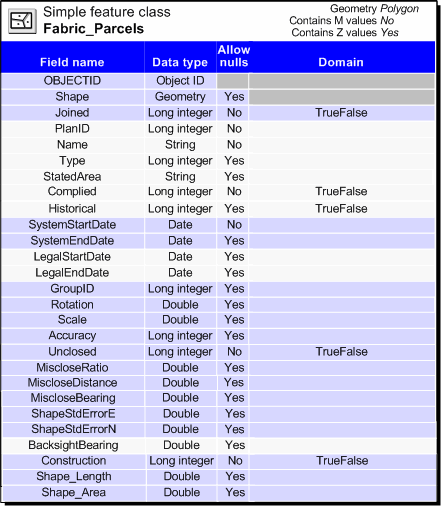
Lines being migrated into the cadastral fabric should have a corresponding feature class of polygons. The polygons are defined by the source parcel lines, and the lines reference left and right polygons by their feature IDs.
Required fields
The following fields are required on your source parcel polygons:
| Field Name | Field Type | Description |
| Your feature class name with an underscore | Long Integer | COGO System field required for data migration |
| PIN (or NAME or LOT or APN) | String | Parcel Identification Number |
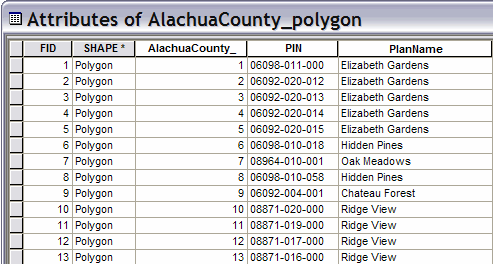
Optional fields
The following fields are optional on your source parcel polygons table:
| Field Name | Field Type | Description |
| Area (or StatedArea) | Double | The parcel area as stated on the plan or record of survey |
| PlanName (or Plan) | String | The name of the plan or record of survey |
| AccuracyCat (or Accuracy) | Long Integer | The accuracy level of the parcel |
| Type | Long Integer | Used for custom subtypes on the polygons (e.g., commercial/residential parcel) |
| Historic | Long Integer | True if the parcel is historic |
| LegalStart (or LegalStartDate) | Date | The date of the legal transaction that created the parcel (i.e., the date on the record of survey) |
| LegalEnd (or LegalEndDate) | Date | The date of the legal transaction that retired the parcel (i.e., the date of the record of survey of the replacing parcel) |
- No Area field: StatedArea = The area of the polygon shape geometry
- No PlanName field: Plan = The name of the feature class being migrated (For example, if there was no PlanName field on the AlachuaCounty_polygon table, the plan name for all parcels would be AlachuaCounty.)
- No AccuracyCat field: Accuracy of all parcels = 3 (default)
- No Type field: Type = NULL
- No LegalStart field: LegalStartDate = NULL
- No LegalEnd field: LegalEndDate = NULL
Control points
Control point data is stored in the Control table in the cadastral fabric. In addition to x,y,z coordinates, the Control table also stores quality information about the control points and whether a control point is active in a least–squares adjustment.
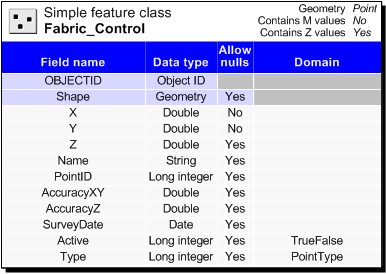
The data migration process supports the following source formats of control points:
- Feature class
- Tables, .csv files
- Survey projects (in Survey Editor)
If you are migrating control points in a feature class, you do not necessarily need to have x,y,z fields with coordinates. Coordinates can be derived from the shape geometry of the point feature class. However, the derived coordinates may not be accurate and correct to the published coordinates of the control points. If you are migrating control points in a .csv file or stand-alone table, x,y,z fields with coordinates are required.
Optional fields
The following fields are optional on your source control points format:
| Field Name | Field Type | Description |
| Name | String | The name of the control point |
| PointID | Long Integer | The point ID of the associated fabric point |
| AccuracyXY | Double | Horizontal positional accuracy of the control point |
| AccuracyZ | Double | Vertical accuracy of the control point |
| Survey Date | Date | The date the control point was established |
| Active | Long Integer | Indicates whether the control point is active in an adjustment |
| Type | Long Integer | Used for custom subtyping on the control points (e.g., benchmark) |
In the screen shot below, fabric control point CP3 is associated to fabric point 5323 (point ID) even though the fabric point location is not accurate with the control point location.
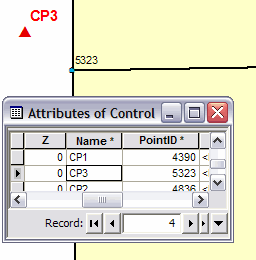
If any of the optional fields are missing on your source control data, corresponding fields on the cadastral fabric control table will have the following values:
- No Name field: Name = A default, autogenerated name, starting at 1 and prefixed with "Auto1", for example, Auto1.1
- No PointID field: PointID = the point ID found within the control point match tolerance
- No AccuracyXY field: AccuracyXY = NULL
- No AccuracyZ field: AccuracyZ = NULL
- No Active field: Active = NULL until the control point participates in a least–squares adjustment
- No Type field: Type = NULL
Migrating control points before parcel data
You can migrate your control points into the cadastral fabric before you migrate your parcel data. You will then set a "match fabric point to control" tolerance instead of a "match control to fabric point" tolerance.